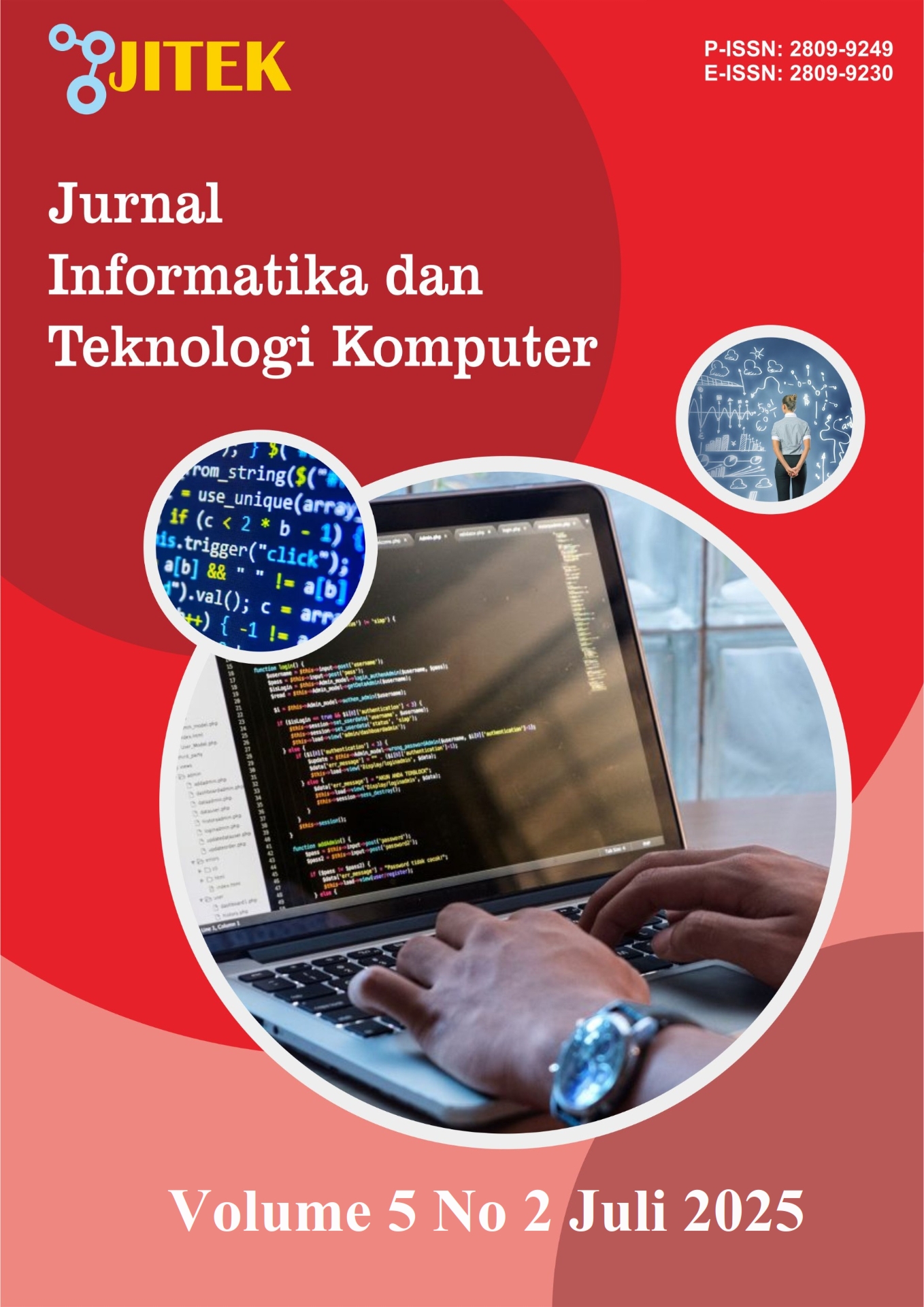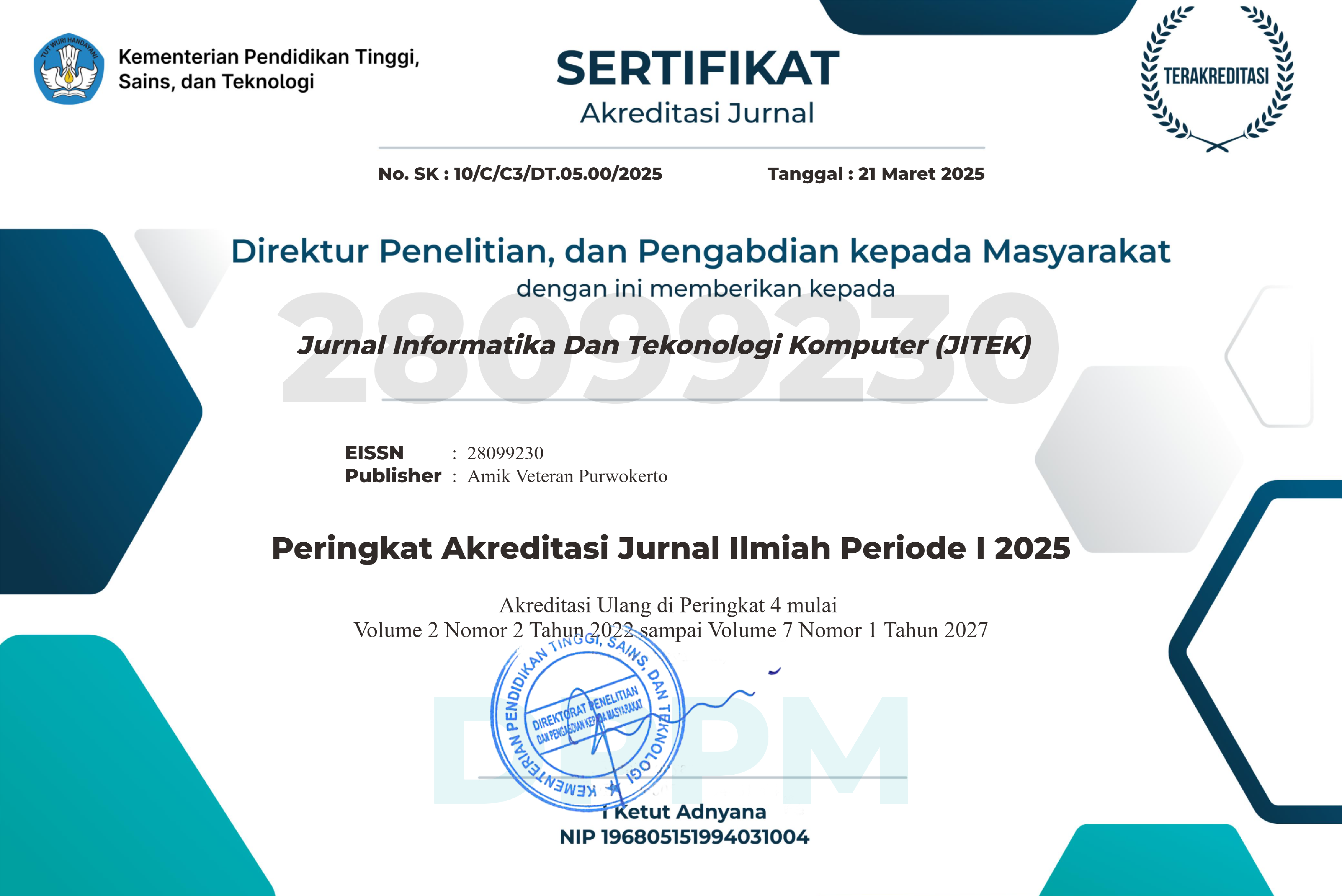SmartBin Medis Berbasis AI dan Edge Computing untuk Manajemen Limbah Klinis yang Higienis
DOI:
https://doi.org/10.55606/jitek.v5i2.6385Keywords:
Medical waste, smartbin, Arduino Uno, artificial intelligence, edge computing, automation, waste classification, clinical hygieneAbstract
Medical waste presents a serious threat to health and the environment if not properly managed, especially in clinical facilities that require high hygiene standards. Manual waste disposal is still commonly practiced, which increases the risk of cross-contamination and reduces operational efficiency. This research aims to design and develop an automated and hygienic SmartBin system for medical waste using Artificial Intelligence (AI) and edge computing technologies without relying on internet connectivity. The system employs distance and weight sensors controlled by an Arduino Uno R3 microcontroller, along with a local image recognition module to classify medical waste based on type. All classification and system responses are processed locally to ensure fast and independent operation. A notification feature using visual and audio indicators is included to alert staff when the bin is full or when hazardous waste is detected. Testing conducted in a simulated clinical environment demonstrated a classification accuracy rate of 92% and reduced direct human contact by up to 85%. This study concludes that the SmartBin system, powered by AI and edge computing and supported by the Arduino Uno R3, offers an effective solution for improving hygiene and safety in medical waste management.
References
[1] Republik Indonesia, Undang-Undang No. 17 Tahun 2023 tentang Kesehatan. Jakarta: Sekretariat Negara, 2023.
[2] R. Rohmah dan P. Liana, “Rancang Bangun Tempat Sampah Otomatis Berbasis Mikrokontroler Arduino Uno dengan Sensor HC-SR04,” JUSIKOM, vol. 1, no. 1, pp. 1–7, 2020.
[3] F. Aini, “Pengelolaan Sampah Medis Rumah Sakit atau Limbah B3 di Sumatera Barat,” Jurnal Kesehatan, vol. 7, 2019.
[4] M. Ichwan, M. G. Husada, M. Iqbal, dan A. Rasyid, “Pembangunan Prototipe Sistem Pengendalian Peralatan Listrik pada Platform Android,” Jurnal Ilmiah Teknik Elektro, vol. 4, pp. 45–50, 2013.
[5] P. Stevano et al., “Implementasi Sensor Ultrasonik HC-SR04 sebagai Sensor Parkir Mobil Berbasis Arduino,” Jurnal Einstein, vol. 5, no. 1, pp. 22–27, 2017.
[6] S. Rachmawati dan T. Yuliana, “Analisis Perancangan Tempat Sampah Pintar Berbasis Arduino,” Jurnal Teknologi dan Sistem Komputer, vol. 8, no. 2, pp. 100–106, 2020.
[7] Pemerintah Kota Semarang, “Profil Kota Semarang 2023 + Lampiran,” Dinas Kesehatan Kota Semarang, 2023. [Online]. Available: https://dinkes.semarangkota.go.id/
[8] Y. Febriana, A. H. Prasetyo, dan S. Rahmawati, “Perancangan Tempat Sampah Otomatis Berbasis Arduino,” Jurnal Teknologi dan Sistem Informasi, vol. 3, no. 2, pp. 35–40, 2019.
[9] F. S. Mubarok, “Smart Trash Bin Berbasis Arduino Menggunakan Sensor Ultrasonik dan Infrared,” Jurnal Teknik Komputer, vol. 10, no. 1, pp. 20–25, 2021.
[10] A. Wibowo dan L. A. Supriyono, “Analisis Pemakaian Sensor Loadcell dalam Perhitungan Berat Benda Padat dan Cair Berbasis Microcontroller,” Elkom: Jurnal Elektronika dan Komputer, vol. 12, no. 1, pp. 1–5, 2019.
[11] L. A. Supriyono, A. Marwanto, dan S. Alifah, “Perancangan Otomasi Alat Infus Berbasis Fuzzy Logic,” Elkom: Jurnal Elektronika dan Komputer, vol. 15, no. 1, pp. 82–88, 2022.
[12] L. A. Supriyono dan A. F. Wibowo, “Sistem Monitoring Suhu, Kelembaban dan Kandungan Nutrisi Budidaya Tanaman Sawi Caisim Hidroponik Berbasis IoT,” Jurnal Ilmiah Teknik Mesin, Elektro dan Komputer, vol. 3, no. 1, pp. 171–178, 2023.
[13] R. Kurniawan, “Tempat Sampah Pintar Menggunakan Sensor Infrared dan Mikrokontroler,” Jurnal Teknik Elektro dan Komputer, vol. 4, no. 2, pp. 58–63, 2020.
[14] A. Pratama, “Desain Tempat Sampah Otomatis dengan Indikator Kapasitas,” Jurnal Teknologi Elektro, vol. 6, no. 1, pp. 12–17, 2018.
[15] H. K. Nugraha dan B. Arifin, “Implementasi Smart Trash Can dengan IoT Berbasis NodeMCU,” Jurnal Informatika dan Komputer, vol. 9, no. 1, pp. 67–72, 2021.
[16] M. Nasution, “Perancangan Tempat Sampah Otomatis Berbasis Arduino dan Sensor Ultrasonik,” Jurnal Sainstek, vol. 5, no. 1, pp. 44–50, 2020.
[17] L. A. Supriyono, S. Yaakub, A. Latif, and N. G. Tunggal, Automasi Masa Depan: AI, Machine Learning, dan Perubahan Dunia Kerja, Get Press Indonesia, 2025.
[18] L. A. Supriyono, Y. Fitrianto, D. Setiawan, K. E. Putranto, dan A. S. Aldila, “Energy Efficiency Analysis of LED, CFL, and In-candescent Bulbs with Smart Energy Management (SEM) Technology,” MEANS, vol. 6, pp. 150–153, 2024.
[19] S. D. Kurniawan dan R. Hidayat, “Sistem Deteksi Penuh pada Tempat Sampah Otomatis Menggunakan Sensor Loadcell,” Jurnal Elektronika dan Robotika, vol. 5, no. 2, pp. 101–108, 2021.
[20] D. A. Putra, “Desain Sistem Tempat Sampah Otomatis Tanpa Internet untuk Area Rumah Sakit,” Jurnal Teknologi dan Rekayasa Sistem, vol. 2, no. 1, pp. 22–29, 2022.
[21] L. A. Supriyono, A. Andhika, A. S. Aldila, dan P. Hartanto, “Integration Hydroponic Aquaculture Systems for Optimizing Catfish Growth Management with Arduino,” Jurnal Informatika Ekonomi Bisnis, pp. 394–398, 2024.
[22] A. Andhika dan L. A. Supriyono, “Integrating Artificial Intelligence into Accounting Systems: A Qualitative Study on User Ex-periences and Challenges,” TELKOMNIKA, vol. 23, no. 3, pp. 664–672, 2025.
[23] S. Rahayu, “Pengembangan Tempat Sampah Medis Ramah Lingkungan,” Jurnal Teknik Lingkungan, vol. 12, no. 2, pp. 23–30, 2020.
[24] A. Widodo, “Inovasi Teknologi dalam Pengelolaan Limbah Medis di Puskesmas,” Jurnal Kesehatan Masyarakat, vol. 11, no. 3, pp. 50–55, 2021.
Downloads
Published
How to Cite
Issue
Section
License
Copyright (c) 2025 Jurnal Informatika Dan Tekonologi Komputer (JITEK)

This work is licensed under a Creative Commons Attribution-ShareAlike 4.0 International License.








